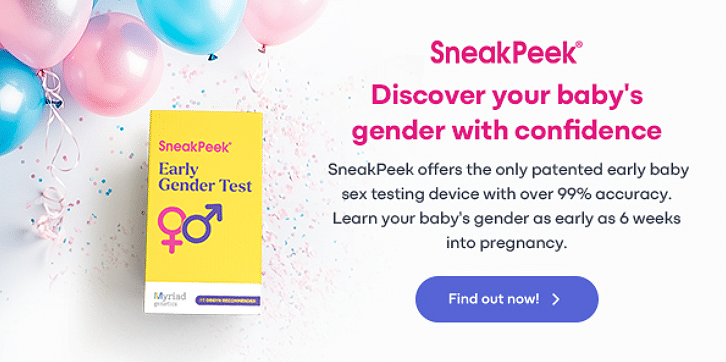Published on June 11th, 2025
Check out SneakPeek Gender Test to find out your baby’s gender as early as 6 weeks with over 99% accuracy!

Learning that you’re pregnant with twins can make for an exciting twist on the journey to parenthood—but it can also stir up double the questions.
One such area of questioning is how to find gender in twin pregnancy?
Unlike singleton pregnancies, where a simple at-home test can predict the sex of your baby, twin pregnancies tend to add a layer of complexity. Fortunately, there are multiple ways to test for sex in a twin pregnancy—though each approach comes with its own set of considerations.
Methods for Determining Sex in a Twin Pregnancy
There are two main approaches healthcare providers use to ascertain the sex of babies in utero:
- By looking for traces of the Y chromosome in a parent’s bloodstream, which indicates the presence of male DNA. (However, when you’re pregnant with multiples, gauging sex comes with the added challenge of not knowing whose DNA is whose, and it may require a little extra testing to get a clearer answer.)
- By looking at the genitals of babies using a 2D ultrasound or another type of ultrasound for pregnancy, which indicate sex based on anatomy.
As an expecting parent, it helps to know which techniques can be used so you feel prepared throughout the process.
#1 Ultrasound
Ultrasounds are one of the most common ways to screen for sex in both singleton and multiple pregnancies. While the 20-week anatomy scan is often considered the traditional gender reveal ultrasound, it’s important to note that people carrying twins typically undergo several ultrasounds well before reaching the 20-week mark.
In most twin pregnancies, an ultrasound is performed around 8 weeks to confirm viability and assess chorionicity—whether the twins share a placenta. A second scan often follows around 12 weeks, and because multiples require closer monitoring, additional ultrasounds are usually scheduled monthly throughout the pregnancy.
By the time you arrive at your 20-week anatomy scan, you’ve likely had at least three earlier ultrasounds. These earlier scans may not always focus on sex determination, but they provide essential insights into fetal development, growth patterns, and overall health—and depending on fetal positioning, they can sometimes offer early clues about your babies’ sex.
#2 Prenatal Cell-Free DNA (pcfDNA)
Prenatal cell-free DNA screening is a type of blood test that checks the fetal DNA present in the pregnant person’s blood. This type of test is used mainly for identifying chromosomal abnormalities, which could lead to developmental conditions like Down’s syndrome.
However, a secondary use of this DNA screening is to determine a baby’s sex, should an ultrasound not provide a clear answer.
The main way pcfDNA screens for sex identification is by looking for a Y chromosome in the bloodstream. If there is one, it’s predicted that at least one of the twins is male. The SneakPeek Prequel prenatal screen, in particular, can also identify whether one or both twins are male. However, if the test detects one male and one female, it can’t identify which baby is which.
Another stand-out quality of pcfDNA screens is their ability to reveal sex-related information earlier than ultrasounds. Typically, Prequel is available at 8 weeks into gestation, though other pcfDNA screenings aren’t available until 10 weeks.
#3 CVS (Chorionic Villus Sampling)
Chorionic villus sampling falls into the category of invasive testing because it requires the retrieval of a small tissue sample. A healthcare provider will take a sample from your placenta and look for chromosomal abnormalities and the Y chromosome. If you have two placentas, they’ll take two samples. If your twins share a placenta, it means they’re identical twins and share the same sex.
CVS is typically performed later, between 10 and 13 weeks of pregnancy.
#4 Amniocentesis
Amniocentesis is another form of invasive testing that’s performed slightly later than CVS and can provide a slightly higher rate of sex prediction accuracy. With this method, a sample of amniotic fluid is taken, and the chromosomes are looked at to identify any genetic conditions, as well as sex.
Amniocentesis is typically conducted between 15-20 weeks of pregnancy. If your twins occupy two different amniotic sacs, two samples may be taken to improve accuracy.
What about ART (assisted reproductive technology) pregnancies?
From late-in-life conception to secondary infertility, there are several reasons to turn to assisted reproductive technology when trying to get pregnant. If you used assisted reproductive technology to achieve pregnancy, methods for predicting sex are a bit different. You can undergo preimplantation genetic testing (PGT-A), which checks all of the chromosomes of your viable embryos for abnormalities. In doing so, the test is also able to identify the sex of each embryo.
It’s important to note that PGT-A is used before your embryos are transferred to your uterus.
Can at-home gender tests be used for twin pregnancies?
At-home early-detection tests are similar to NIPT, but they have the advantage of being conducted from the comfort of your home rather than a medical facility. With the SneakPeek Early Gender Test, the testing process is fast, easy, and over 99% accurate. Here are the steps for this simple, effective gender test:
- Receive your test – Following your order, you’ll be mailed an at-home test kit. You’ll use this kit to take a small blood sample at your convenience.
- Mail your sample – After you’ve retrieved your sample, you’ll pack it up and mail it securely to the SneakPeek lab.
- Receive your results – Once received, the SneakPeek lab will review your sample and send you the results.
Wondering “How early can I know the gender of twins?” With the SneakPeek test, you can test as early as 6 weeks into gestation.
Like other methods, predicting gender with an at-home blood test can be more complex when you’re pregnant with multiples. This gender test works by analyzing your blood for male DNA. If you’re pregnant with identical twins, the result will apply to both babies—male DNA means you’re having two boys, and no male DNA means you’re having two girls. In the case of fraternal twins, detecting male DNA confirms that at least one baby is a boy, but the test can’t determine the sex of the second baby.
If your blood test results predict you’re having a boy, you can investigate again using one of the other methods described above to learn whether you can expect just one Mr. Baby, or two!
Planning Prenatal Care for a Twin Pregnancy
Whether you’re expecting one or more, knowing your babies’ sex is just one (or, in twins’ cases, two) aspect of preparing for their arrival.
Being pregnant with multiples requires a degree of foresight and extra planning to ensure the healthiest, happiest possible pregnancy and delivery process.
These tips will help you feel prepared for your twosome, no matter what surprises they have coming down the pike.
Choose a Healthcare Provider with Twins Experience
Not every OBGYN has experience with twin pregnancies. If you can, locate a healthcare provider who specializes—or at least has a history of—assisting parents who are pregnant with multiples.
Prioritize Nutrition and Balance
While you won’t need to double your caloric intake during a twin pregnancy, it’s estimated your daily energy needs could increase up to 40% during a twin pregnancy.
But as with all things health-related, quality matters as much (or arguably more) than quantity. It’s best to keep a balanced plate when eating for multiples, with a diet focused on:
- Whole foods
- Whole grains
- Lean proteins
- Healthy fats
Additionally, taking a doctor-approved prenatal vitamin will help ensure you get sufficient amounts of folic acid, iron, and calcium—important nutrients needed to support healthy fetal development.
Keep Track of Weight Gain
On average, the American College of Obstetricians and Gynecologists recommends a weight gain of 37 to 54 lbs for women with a normal starting weight over the course of a twin pregnancy. However, gaining too much weight (or too much weight too quickly) could augment the chances of preterm birth).
With that, it’s important to work with your healthcare provider to establish a healthy pace of weight gain for you and your babies. Embracing the keystones of a healthy lifestyle—like eating a balanced diet and moving daily—is foundational for encouraging a healthy rate.
Plan for More Frequent Appointments
As a general rule, twin pregnancies mean more prenatal check-ups to ensure both babies receive adequate monitoring. Twins can heighten several risks that could complicate fetal health, pregnancy, and labor, such as:
- Delayed development in one or more babies
- Gestational hypertension
- Gestational diabetes
- Abnormal amniotic fluid amounts
- Labor or delivery complications
More frequent check-ups give your healthcare provider the opportunity to screen for irregularities, like abnormal amniotic fluid levels, and ensure each of your babies is growing at a healthy rate.
Keep an Eye Out for Preterm Labor Signs
Twins are more likely to be born early, so it’s helpful to familiarize yourself with signs of preterm labor. These include:
- Regular or frequent contractions
- Lower back pain or uterine cramping
- A feeling of increased pelvic pressure
- Vaginal leakage or bleeding
If you feel any of the listed pregnancy symptoms, be sure to reach out to your provider immediately.
Get Plenty of Rest
Being pregnant with one baby is demanding enough, but being pregnant with multiples means you may experience more fatigue than a typical singleton pregnancy. Allowing yourself to get adequate, high-quality rest will help you enjoy the rosier parts of pregnancy without feeling too tuckered out along the way.
Discover Who’s On the Way with The SneakPeek Early Gender Test®
If you’re eager to find out who your twosome could be, join the over 1 million parents who have used the SneakPeek test.
With our simple-to-use, at-home Early Gender Test, you can learn your baby’s predicted sex as early as 6 weeks into gestation and with over 99% clinically proven accuracy.
Whether you’re eager to start planning your nesting party or ready to throw an extravagant gender reveal for twins, SneakPeek has you covered. Find out why the SneakPeek test is the #1 OBGYN-recommended at-home early sex prediction test* by ordering yours today.
*SneakPeek recommended six to one among 100 OBGYNs survey
Editorial Policy
At SneakPeek, our commitment is to provide accurate, up-to-date, and reliable information to empower our readers. Our content is thoroughly researched, reviewed by medical experts, and fact-checked to ensure its credibility. We prioritize the well-being and education of our readers, and our editorial policy adheres to the highest standards of integrity and accuracy in all our articles.
This post has been reviewed for accuracy by the following medical professional:
Dr. Stitt is a board-certified OB/GYN with over 20 years of experience providing compassionate care to women throughout every stage of pregnancy and childbirth. She is currently the medical director for a large group practice in Annapolis, Maryland and is actively involved in training both OB/GYN residents and medical students. Dedicated to patient education and empowerment, Dr. Stitt is passionate about helping women make informed decisions about their health, from prenatal care to postpartum recovery. Known for a warm and supportive approach, Dr. Stitt strives to create a positive and reassuring experience for expectant mothers, ensuring they feel confident and well-prepared for the journey of motherhood.
Sources:
- Parents. Are Identical Twins Always the Same Sex and Gender? https://www.parents.com/are-identical-twins-always-the-same-sex-8627683#toc-when-you-can-find-out-the-sex-of-twins
- Baby Center. Everything you need to know about the NIPT test. https://www.babycenter.com/pregnancy/health-and-safety/nipt-noninvasive-prenatal-testing_10404483
- National Library of Medicine. Fetal sex determination in twin pregnancies using non-invasive prenatal testing. https://pubmed.ncbi.nlm.nih.gov/31285848/
- Health. Can You Choose Gender With IVF? https://www.health.com/condition/pregnancy/is-it-actually-possible-to-choose-a-babys-gender-through-ivf
- Johns Hopkins Medicine. Twin Pregnancy: Answers from an Expert. https://www.hopkinsmedicine.org/health/conditions-and-diseases/staying-healthy-during-pregnancy/twin-pregnancy-answers-from-maternal-fetal-medicine-specialist
- The American College of Obstetricians and Gynecologists. Weight Gain During Pregnancy. https://www.acog.org/clinical/clinical-guidance/committee-opinion/articles/2013/01/weight-gain-during-pregnancy
- Johns Hopkins Medicine. Complications of Multiple Pregnancy. https://www.hopkinsmedicine.org/health/conditions-and-diseases/staying-healthy-during-pregnancy/complications-of-multiple-pregnancy
- The American College of Obstetricians and Gynecologists. Preterm Labor and Birth. https://www.acog.org/womens-health/faqs/preterm-labor-and-birth
- Mayo Clinic. Twin pregnancy: Getting ready for twins or multiples. https://www.mayoclinic.org/healthy-lifestyle/pregnancy-week-by-week/in-depth/twin-pregnancy/art-20048161
- NHS Inform. Twins and multiple births. https://www.nhsinform.scot/ready-steady-baby/pregnancy/your-baby-s-development/twins-and-multiple-births/
- OBGYN Associates of Idaho Falls. Are There Any Differences Between Single and Twin Pregnancy Symptoms? https://obgynif.com/difference-between-single-and-twin-pregnancy-symptoms/
- Medline Plus. Prenatal Cell-Free DNA Screening. https://medlineplus.gov/lab-tests/prenatal-cell-free-dna-screening/








